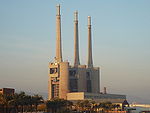User:Montecara/Sandbox 1: Difference between revisions
| Line 70: | Line 70: | ||
Montecara consumes about 14.35 billion kW·h of electricity per year. | Montecara consumes about 14.35 billion kW·h of electricity per year. | ||
Montecara is in the process of moving away from fossil fuels and toward sustainable energy but badly lags behind schedule in its goal, set in 2000, to achieve 100% renewable electricity by 2025. Less than ten percent of the electricity generated in Montecara comes from a renewable source, with the remaining more than ninety percent coming from oil and natural gas. | Montecara is in the process of moving away from fossil fuels and toward sustainable energy but badly lags behind schedule in its goal, set in 2000, to achieve 100% renewable electricity by 2025. Less than ten percent of the electricity generated in Montecara comes from a renewable source, with the remaining more than ninety percent coming from oil and natural gas. There are several obstacles to increased use of renewables: limited land area means that there is little free space to deploy solar panels, the terrain is not generally favorable to onshore wind power, and high land values mean that land-intensive renewable plants are prohibitively expensive to build and maintain. | ||
{{wp|Nuclear power}} is a highly contentious political issue in Montecara. Montecara has been a {{wp|nuclear-free zone}} since 1985 in response to plans by [[Comega]] to build a {{wp|boiling water reactor}}. | {{wp|Nuclear power}} is a highly contentious political issue in Montecara. Montecara has been a {{wp|nuclear-free zone}} since 1985 in response to plans by [[Comega]] to build a {{wp|boiling water reactor}}. | ||
Montecara must import all its fossil fuels and is therefore highly dependent on the flow of international shipping to supply its energy needs. | Montecara must import all its fossil fuels and is therefore highly dependent on the flow of international shipping to supply its energy needs. Tanker ships arrive several times per week with supplies of oil and liquefied natural gas, and the state estimates that if its sea lanes were disrupted, fuel and power shortages would likely develop within less than 48 hours. | ||
An interconnector cable built into the [[Bridge]] allows electricity to be exported to and imported from [[Mespalia]] as needed. | |||
=== Power plants === | === Power plants === | ||
{{Template:Comega plants}} | {{Template:Comega plants}} | ||
== Regulation == | |||
The [[Secretary of the Environment, Transport, and Urban Development]] has authority over energy regulation in Montecara | |||
== Transportation == | == Transportation == | ||
Revision as of 20:18, 23 July 2019
Electricity
| Data | |
|---|---|
| Electricity coverage | 100% |
| Continuity of supply | 99.99% |
| Installed capacity (2017) | 4795 MW |
| Share of fossil energy | 92.28% |
| Share of renewable energy | 7.72% |
| Average electricity use (2017) | 8,194 kW·h per capita |
| Services | |
| Share of private sector in generation | 100% |
| Competitive supply to large users | No |
| Competitive supply to residential users | No |
| Institutions | |
| Responsibility for transmission | Comega |
Montecara consumes about 14.35 billion kW·h of electricity per year.
Montecara is in the process of moving away from fossil fuels and toward sustainable energy but badly lags behind schedule in its goal, set in 2000, to achieve 100% renewable electricity by 2025. Less than ten percent of the electricity generated in Montecara comes from a renewable source, with the remaining more than ninety percent coming from oil and natural gas. There are several obstacles to increased use of renewables: limited land area means that there is little free space to deploy solar panels, the terrain is not generally favorable to onshore wind power, and high land values mean that land-intensive renewable plants are prohibitively expensive to build and maintain.
Nuclear power is a highly contentious political issue in Montecara. Montecara has been a nuclear-free zone since 1985 in response to plans by Comega to build a boiling water reactor.
Montecara must import all its fossil fuels and is therefore highly dependent on the flow of international shipping to supply its energy needs. Tanker ships arrive several times per week with supplies of oil and liquefied natural gas, and the state estimates that if its sea lanes were disrupted, fuel and power shortages would likely develop within less than 48 hours.
An interconnector cable built into the Bridge allows electricity to be exported to and imported from Mespalia as needed.
Power plants
| Name | Image | Type | Capacity (MW) | Commissioned |
|---|---|---|---|---|
| Nùvol power plant | Natural gas (primary) Oil (secondary) |
1050 (3 × 350) | 1982 | |
| Siròco Nòvo array | Offshore wind | 309 | 2013 | |
| Cocàl regeneration plant | Waste-to-energy | 85 | 1999 |
Regulation
The Secretary of the Environment, Transport, and Urban Development has authority over energy regulation in Montecara


